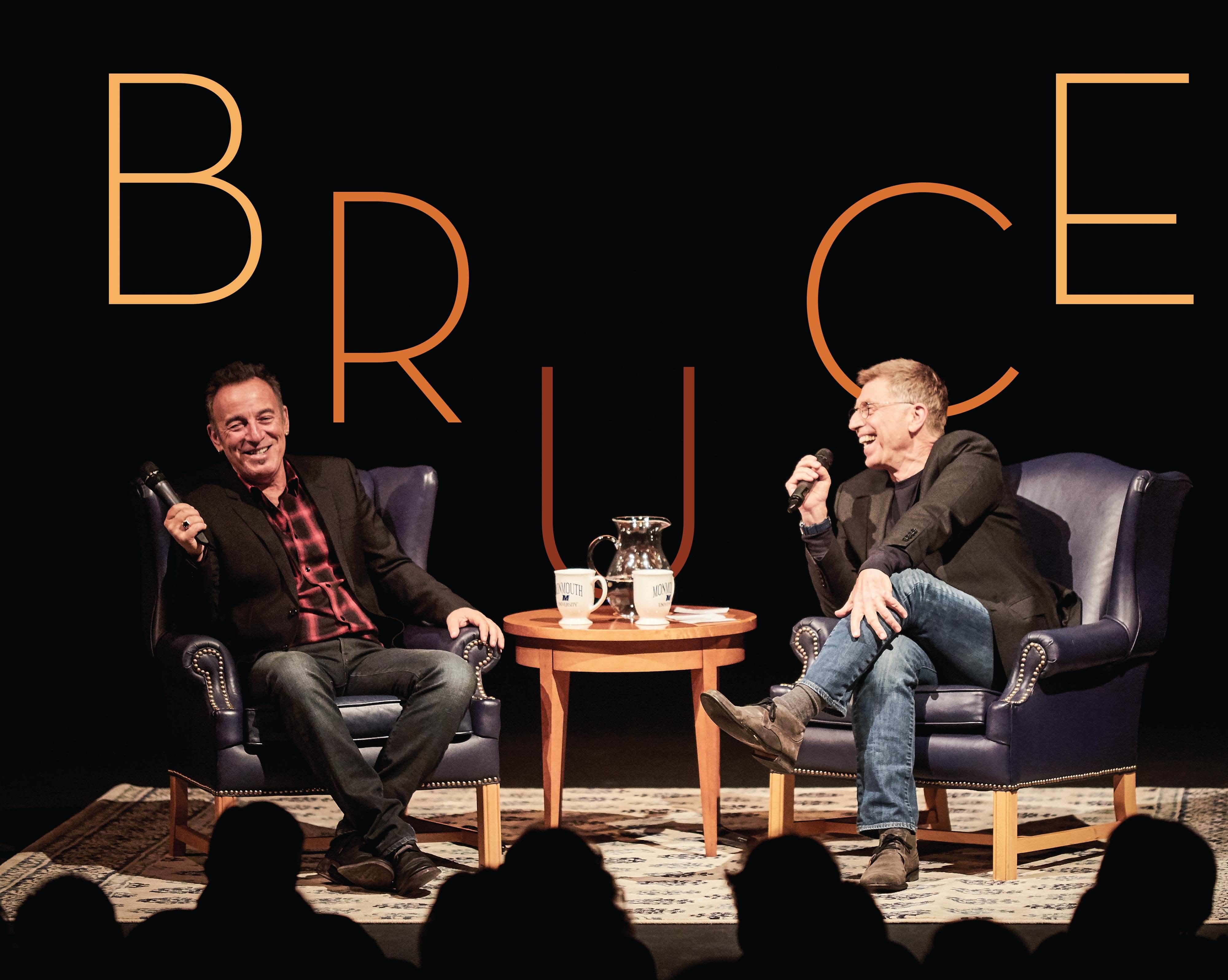
Bruce
The Boss returns to Monmouth for a candid conversation and to mark the start of a new partnership with the university.
On the night a rock and roll legend took the stage in Pollak Theatre to share stories about his career, it was a pre-show announcement from President Paul Brown that provided the most newsworthy takeaway.
While welcoming the sell-out crowd to January’s “A Conversation with Bruce Springsteen,” Brown announced a new collaborative partnership to establish The Bruce Springsteen Archives and Center for American Music at Monmouth University. Through the collaboration, Monmouth becomes the official archival repository for Springsteen’s written works, photographs, periodicals, and artifacts.

The news elicited applause that only amplified with Springsteen’s arrival on stage moments later. The evening marked a homecoming of sorts for the singer, who regularly performed on campus in the 1960s and 1970s. That’s where moderator Robert Santelli ’73, executive director of the Grammy Museum, started the conversation, asking Springsteen about his appearances on the Great Lawn and in the college gymnasium.
“I played some big shows here,” Springsteen recalled, smiling. “At $1 per head, 2,000 people—that money lasted a long time.”
Sitting center stage, opposite Santelli, Springsteen was funny, candid, and at times disarmingly modest throughout the 90-minute conversation. At one point he recalled how as a teen, he watched bands perform at CYO dances in Freehold, New Jersey. Looking at lead singers and guitarists, he’d tell himself, “I can’t do that.” He didn’t understand the bass, and drums were too expensive, he said, so he focused on the rhythm guitarist, standing in the back, strumming chords, and “looking cool.”
“I could be that guy,” Springsteen said.
When Columbia Records signed him in the early 1970s, Springsteen recalled, you were either a New York or California artist. Record executives wanted him to be the next Bob Dylan and for audiences to associate him with the Big Apple. But Springsteen wanted to remain loyal to his Jersey roots. A postcard he saw on the Asbury Park boardwalk gave him the idea for his first album title and cover.
“I pulled it out and said, ‘Yeah, Greetings from Asbury Park,’” Springsteen said. “That’s New Jersey. Who’s from New Jersey? Nobody. It’s all mine!”
As Springsteen detailed his journey from up-and-comer to critical darling with meager album sales to international superstar, he kept fans entertained—and laughing. Some highlights:
About his early songwriting techniques: “I had a rhyming dictionary and I was going with it 100 percent,” said Springsteen.
On the pressure he felt to make a hit album following lackluster sales on the first two: “Outside forces could never put more pressure on me than I put on myself.”
On the universal appeal of “Born in the U.S.A.”: “That song has been interpreted and misinterpreted so many times it appeals to everyone.”
On his epic 2009 Super Bowl halftime performance: “It was the most terrifying and thrilling 12 minutes of my work life.”
Throughout the conversation, Springsteen touched on many of the same events chronicled in his autobiography, Born to Run. (Was it therapeutic to write, asked Santelli. “I’ve benefited a lot from the therapeutic value of therapy,” the singer joked.) Nonetheless, fans were thrilled to hear Springsteen share those stories in person.
“The event was a once-in-a-lifetime experience,” said Albert Holguin, a music industry major and one of the audience members called on to ask Springsteen a question. “Very rarely does one get to hear about the behind-the-scenes story that led to success, especially for an artist as successful as Bruce Springsteen.”
Springsteen, never one to shy away from talking politics, kept the conversation focused on his career. But one of the last audience members to ask a question that night asked him about his activism.
“Music is important to activism in the sense that it stirs passion,” said Springsteen. “It stirs interest… [and] curiosity. It moves you to question your beliefs and strikes straight to your emotions. After you’ve heard it, it marinates inside you and ends up coming out in your own energy.”
The music of activist artists like Arlo Guthrie and Pete Seeger is important in the same way hymns are important to churchgoers, said Springsteen. “It makes us stronger in our beliefs. And in a certain moment, the right song can start a fire.”
Additional reporting by Breanne McCarthy and Tiffany Wysocki.
Bruce, The Institution
The new collaboration broadens an existing relationship between Springsteen and Monmouth University, which has served as the home of the Bruce Springsteen Special Collection since 2011. The Bruce Springsteen Archives and Center for American Music will preserve and promote the legacy of Bruce Springsteen and his role in American music while honoring and celebrating icons of American music like Woody Guthrie, Robert Johnson, Hank Williams, Frank Sinatra, and others. The expanded partnership will help to more deeply integrate the history and inspiration of American music into the curriculum and research experience at Monmouth. It will also serve to bolster an already highly successful music industry program at the university.
“Monmouth University is excited by the opportunity to grow our relationship with Bruce Springsteen,” Monmouth University President Paul R. Brown said in a statement. “Our partnership has been a natural one—just steps from Springsteen’s birthplace and the site where Born to Run was written, Monmouth University’s location brilliantly captures the essence of Springsteen’s music while providing the academic heft of one of only nine university affiliates of the Grammy Museum. The establishment of The Bruce Springsteen Archives and Center for American Music celebrates and reinforces the Jersey Shore’s legacy in the history of American music, while providing a truly transformative experience for our students.”